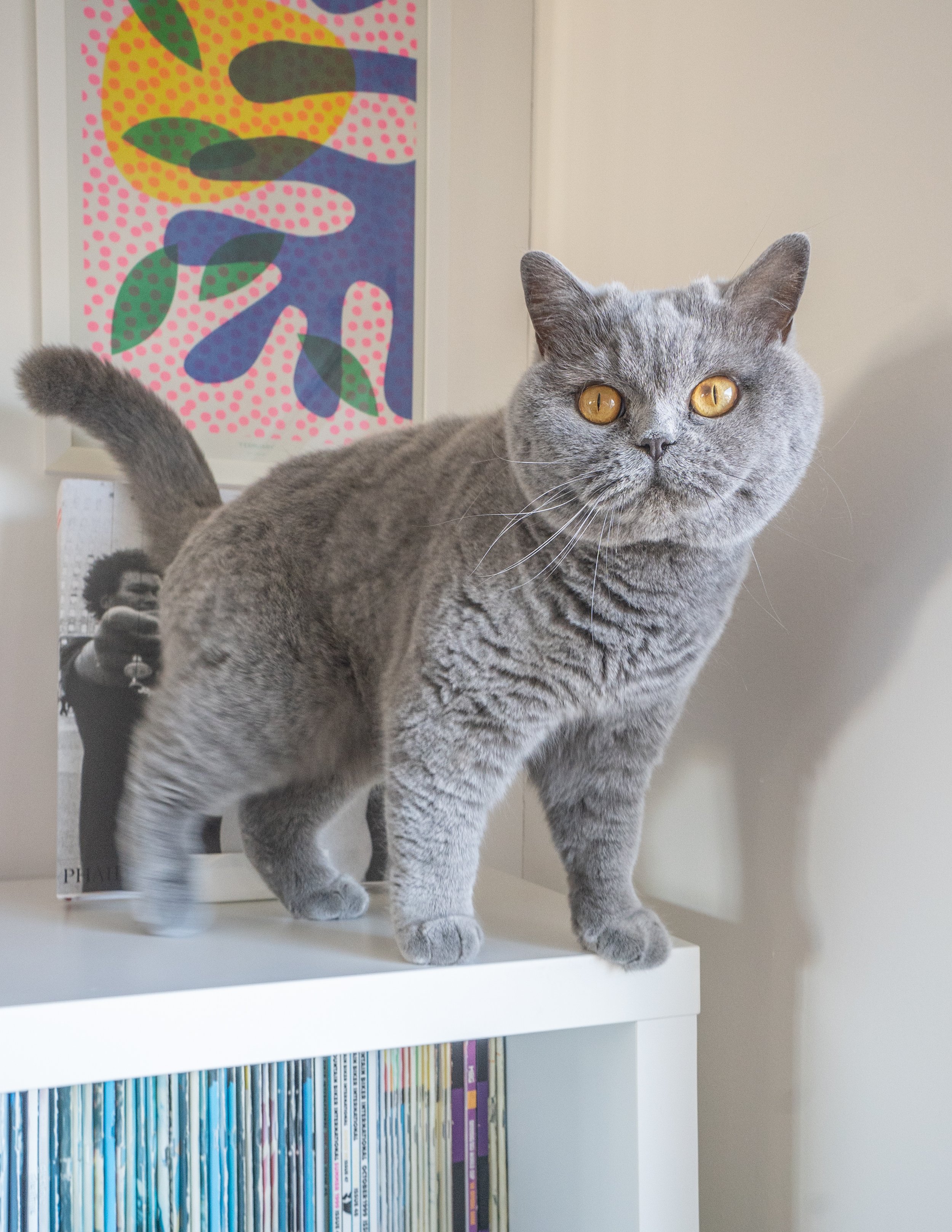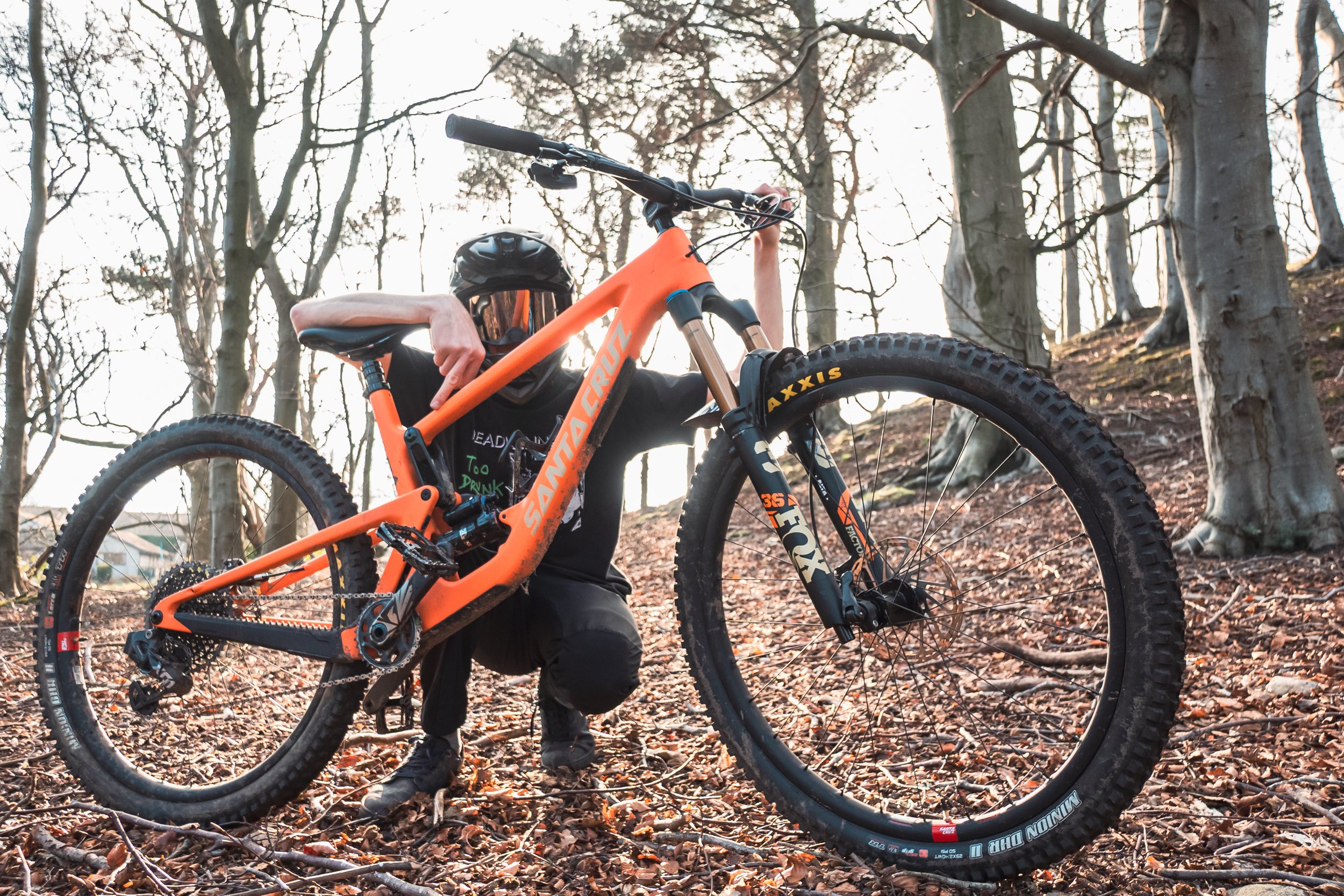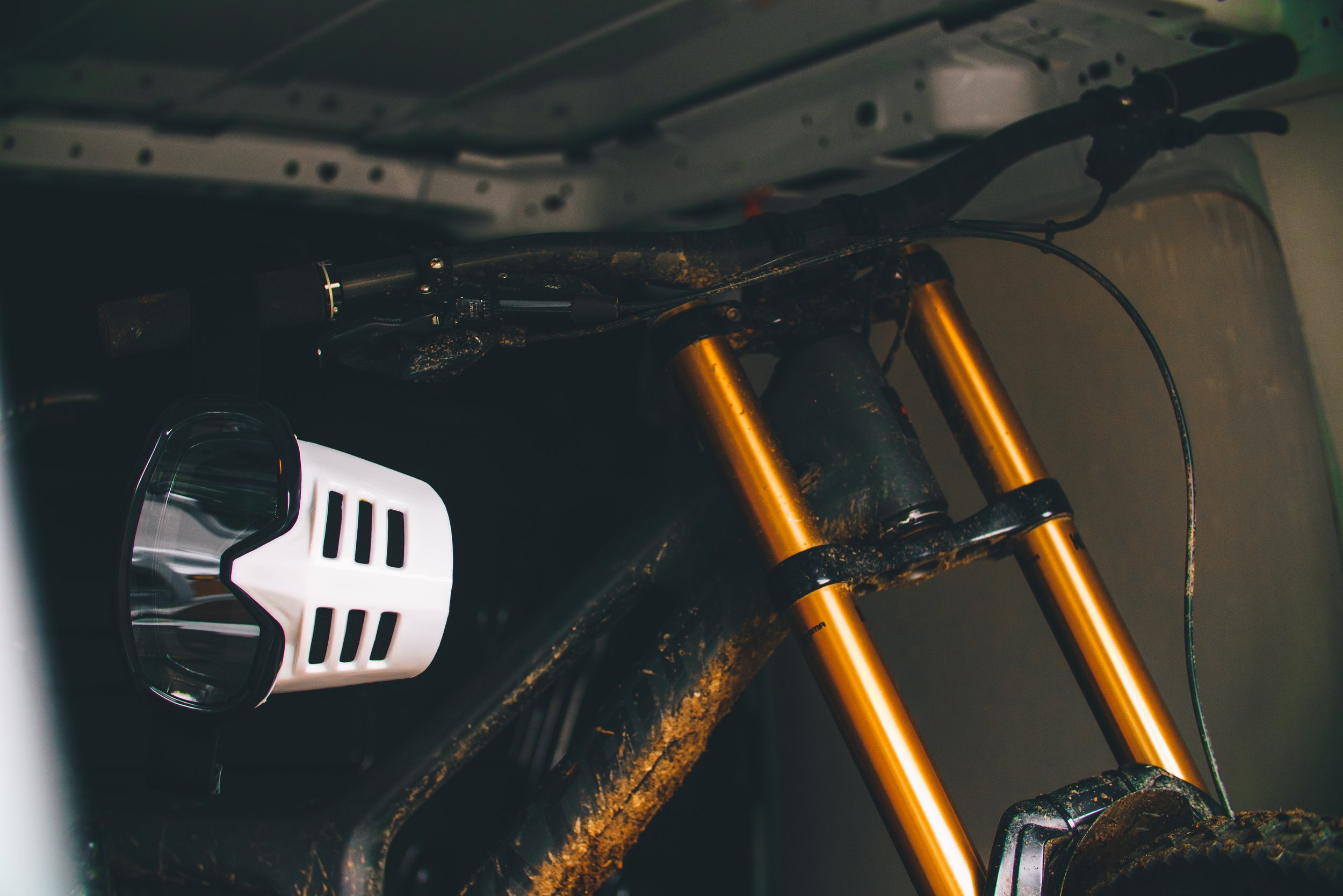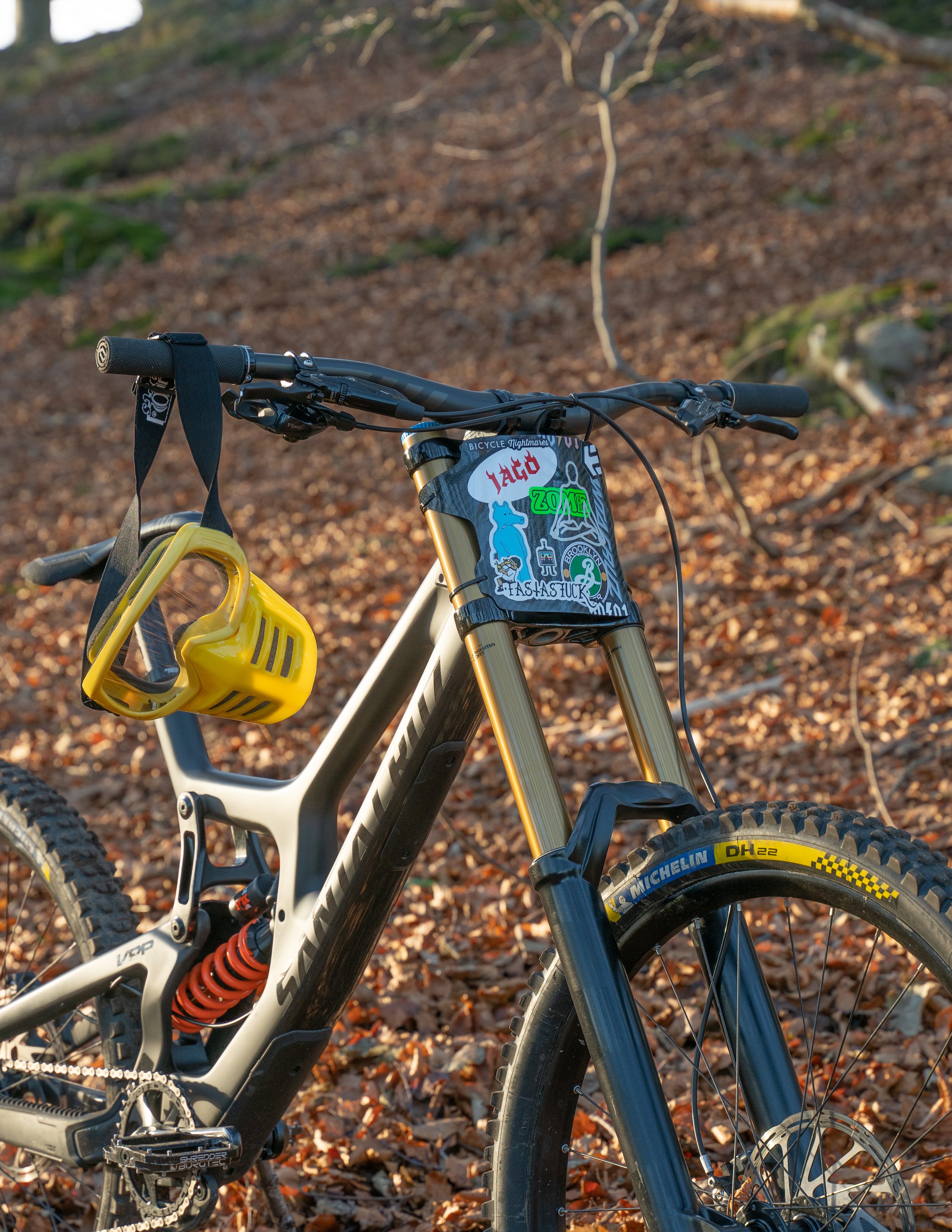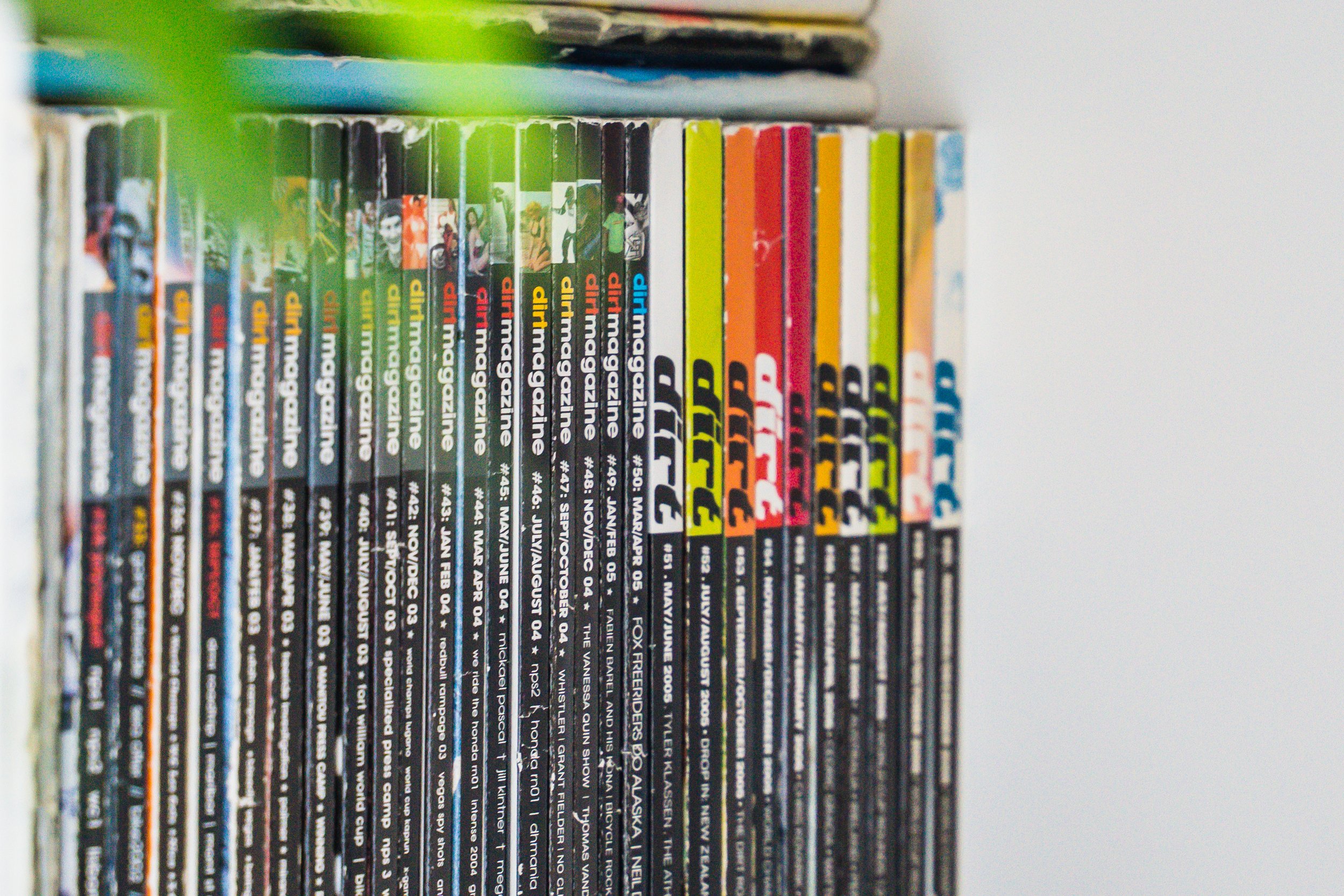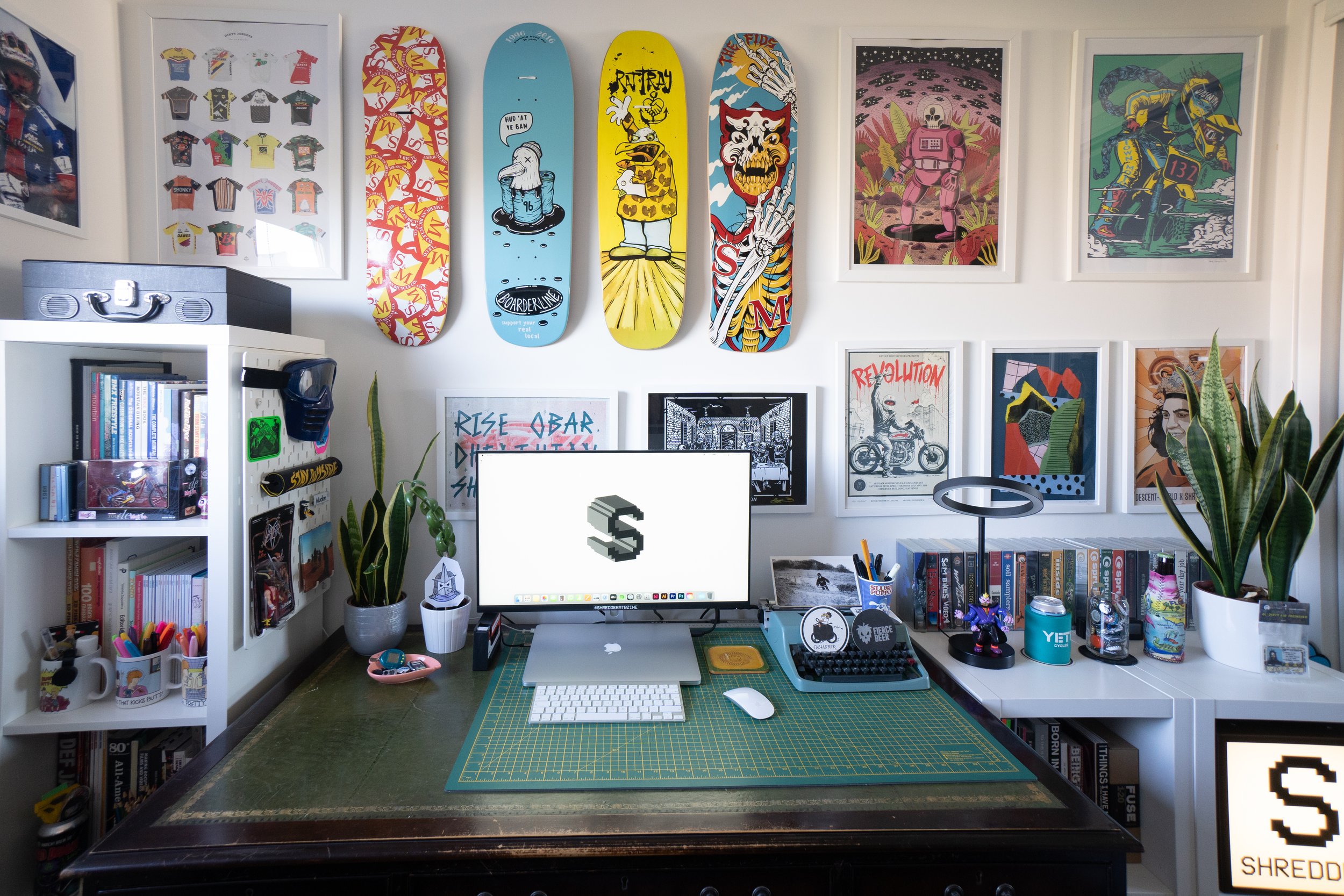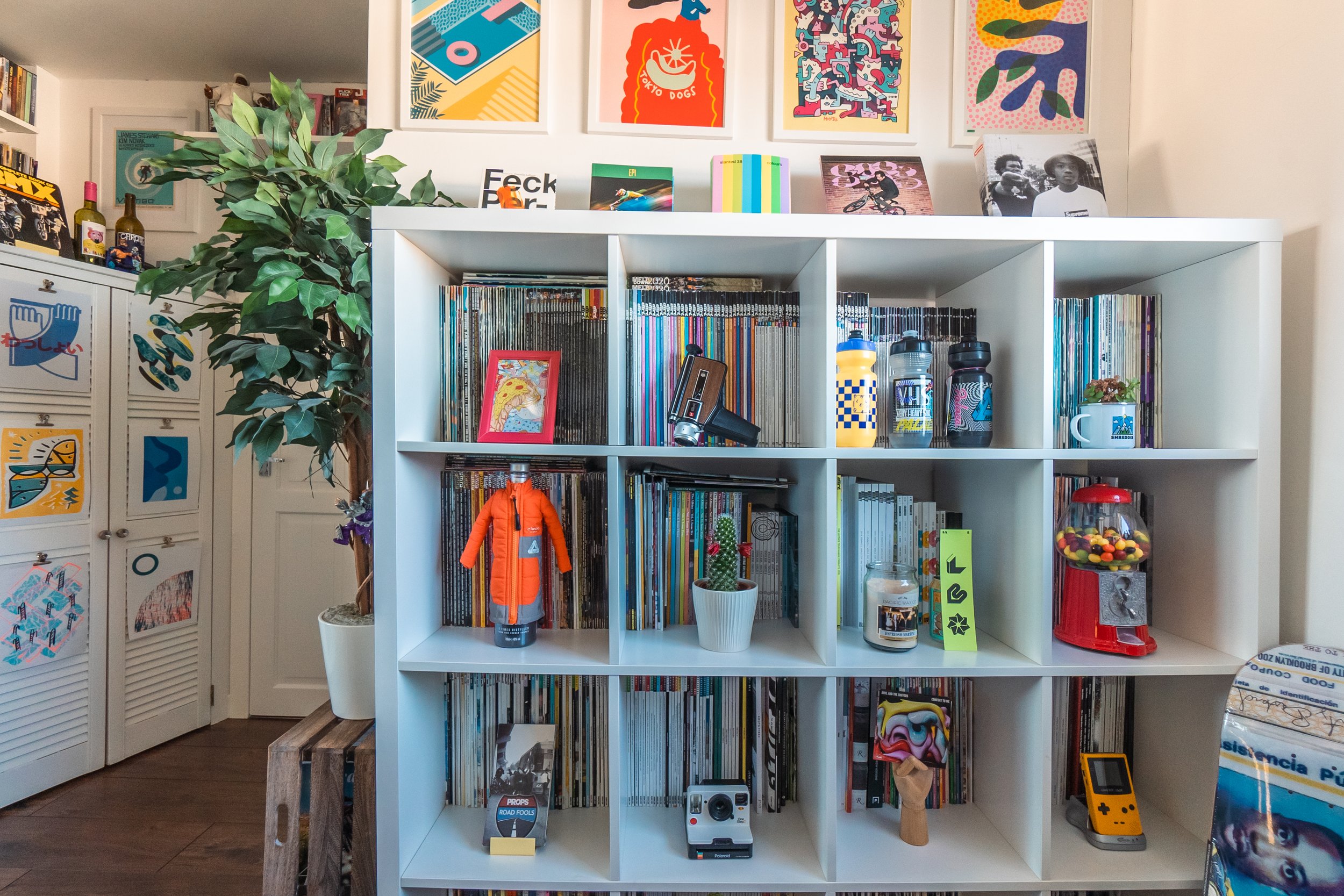Stuart Leel
Intro
Stu is the inspiring creator behind Shredder, a ‘counter culture’ mountain bike magazine with an emphasis on documenting style, and opinions pieces in an old school format that makes it ever more special.
Photos by Adam McGuire
Describe yourself.
I’m a bike obsessive living in Aberdeen, Scotland. I work as a Graphic Designer at a local paper mill and spend my spare time riding bikes and making a printed zine called Shredder. I also have significant enthusiasm for music, pizza, beer and cats.
How would you explain Shredder for someone unfortunate enough to not know of its existence?
Shredder is my representation of everything I love about mountain biking. It’s a publication featuring a collection of stories, opinion pieces and interviews with some of the most interesting individuals within our world of MTB. I like to focus on the underdogs, riders with alternative or unique views, and generally the more creative side of riding.
How did your past pave the way for you and therefore influence who you are today?
I’ve been interested in bikes for as long as I can remember. I started mountain biking when I was 8, from there I rode as often as I possibly could and took great pride in building dirt jumps and trails in my local area. When I was 16 years-old I started working in my local bike shop and progressed through the ranks, from tea boy to manager over the course of 11 years. During my time at the shop I bought a video camera and spent a few years attending downhill races, I documented the Scottish riding scene with short edits that I shared online. In 2014 I decided to study Visual Communication at the North East Scotland College which was my gateway to starting Shredder.
Bikes have played a major role in influencing who I am today, whether that be learning from an experience on a riding trip, overcoming a challenge at the bike shop or even just reading an inspiring article in a bike magazine. Through bikes I’ve met my best friends, and through Shredder I’ve been introduced to so many likeminded individuals who continue to inspire me.
How did issue 1 come into existence and then go forward thereafter?
Before I started studying I had never opened any design software on a computer, so my time at the college was spent mostly getting my head around Illustrator, Photoshop and InDesign. I struggle to look back at my early design work without cringing, but I appreciate all the work I did throughout that time as it helped me understand the process and develop my design skills. At the end of my 2 year course I was presented with the task of making up my own brief. I had 4 weeks to work on the project, so I thought it would be an amazing opportunity to challenge myself to make my own mountain bike publication. This was right at the start of summer 2016 and I had already made a few trips to Fort William to ride that year. I have a real love/hate relationship with the World Cup track there; it’s incredible riding some of the worlds most demanding terrain, and I love the feeling at the end of the day knowing I’ve really pushed myself. The hate side of it comes from the horrendous crashes I’ve had on that track, which have been some of the worst I’ve ever had due to the extremely unforgiving terrain. My original idea was to make a zine about my experiences with riding that track, sort of like an ode to one of my favourite places to ride. I finished my original concept within a few days and realised I could really push myself to make something with a lot more substance. I contacted a few of my favourite Scottish riders for interviews, I wrote a few opinion pieces and designed it in a way that matched the topics being covered. It made for a lot of late nights and early mornings, but I think back to that time fondly and I’m proud of what I was able to piece together within the timeframe.
I initially thought it would be a one-off project, I’d release it for free at my end of year college show and I’d go on to do whatever would come next. When I shared the zine online I received some really positive feedback as I think a lot of riders were ready for an alternative to the limited mountain bike magazine selection available at that time. From there, I’ve just continued to work away on each issue in my free time. I think my design layouts and writing have improved with each issue, which in turn keeps me motivated to continue building on what I’ve previously done - its really rewarding in that respect. The feedback I’ve received is another reason I continue making Shredder, I really can’t thank everyone who has supported what I do over the years enough!
What's the process for bringing an issue to fruition?
It’s a long process which usually starts off with me making some barely readable notes in my sketchbook. I normally write out a list of riders I want to feature and start scribbling down topics I want to cover. The next step is to ask the riders if they want to be involved, before consuming as much information about the individuals as possible. I tend to know most of the basic information before interviewing, but I think it’s important to do as much research as I can to ensure I'm not just asking the same questions that may have appeared in previous interviews. Once the interviews/opinion pieces are typed out and photos are in place, I spend a lot of time researching various art and design styles and work into concepts for the layouts. An important part for me is to visually represent what the article is about in my own style. Once I’ve designed the zine I proofread it, ask my wife to proofread it, amend all the spelling mistakes I didn’t pick up on, send the finished publication to print and start working on a short video to announce the launch of it. Once launched, I pack the orders, post them, reply to emails and create posts for Instagram. After a few weeks have passed I start thinking about the next issue and the whole process begins from scratch. There’s a lot of tedious and mundane tasks involved, but interacting with interviewees, the designing of the zine and gaining feedback from riders who have purchased the finished product are definitely the highlights of the whole process for me.
Are there any standout anecdotes or striking stories you've uncovered via Shredder?
There’s been so many cool things I’ve learnt through making Shredder, I think every single rider I’ve interviewed has said something that’s resonated with me or really made me think.
Every time I email Sven Martin I learn something about a rider or a race that I didn’t previously know about. In my opinion, the man is a living legend! He’s my favourite photographer, so to have his work and wise words grace the pages of my zine really means a lot to me.
Ollie Hindley is another character who always has a good story. He has a unique outlook towards mountain biking, and life in general, so I’m always down to have him involved with Shredder whenever I can.
Explain the 'outdated' media format theme that is apparent in the style and aesthetic of Shredder.
Understandably, I’ve had a few people question why I make a magazine when it would be a lot easier to just share content online. The ‘outdated media format’ was really just poking fun at that mentality, and acknowledging that it is an old school way to do things, but proving that there’s still a place for it.
Dirt Magazine was a huge part of my life growing up, I don’t think Mark Noble’s contribution to bike media is recognised enough - I can’t put into words just how important Mark’s influence and vision was/is when it comes to bike publications in general. The work of Chris Noble, Justin Day, James Bettinson, Jon Gregory and Chris Jones isn’t celebrated enough either in my opinion; I believe as art directors they helped define a cool, relatable visual identity for mountain biking during a time when media outlets were struggling to appeal to a lot of riders. The design style of Shredder is very different to that of Dirt, but it certainly provided a blueprint and laid down the foundation of what a mountain bike magazine could look like.
Going back to outdated media, more recently I’ve applied older media techniques to my design process and have enjoyed getting away from my computer to make parts of the zine in a more DIY, punk zine influenced style. I enjoy using things like a photocopier, Sellotape, glue, Tipp-Ex and a disposable camera to create a lo-fi feel, but I equally enjoy a more modern, stripped back, clean and minimal aesthetic. I try my best to mix up the layouts to suit the theme of the article as best as I can. Issue 8 and 9 feature the work I’m most proud of so far as they fuse a lot of Swiss inspired design with more erratic and messy, legibly challenging spreads.
How do you discover or create the non-MTB related content of your publications which flows into your work?
Outside of riding bikes my biggest interest is music. I’m constantly looking for new tunes to listen to and have a long list of radio shows and mixes I listen to weekly to keep up to date with lots of different genres. I think music is a massive inspiration for most mountain bikers, be that for racers trying to get psyched up before a race or a freerider searching for the next song for their edit. I talk about music a lot in Shredder and have included gig reviews in most of the issues.
To me, it just made sense to break up the riding with some of my non-bike related influences. I’m also a big fan of art and design, so try my best to include artist and illustrators to showcase their work in each issue. It brings another perspective into the zine and hopefully puts readers onto something different that they might not have discovered otherwise.
Can you try and put your finger on what you mean by MTB counter-culture and how that dictates what you choose to portray and the style of Shredder.
The dictionary definition of counter-culture states “a way of life and set of attitudes opposed to or variance with the prevailing social norm”. I’m not claiming to write about some far fetched phenomenons that no one else is covering, but I think of it more of a place for likeminded riders to discuss lesser talked about topics. I think the publication being completely advert free adds to this - there’s no bias, no right or wrong answers and no money coming in from outside sources to manipulate any of the articles.
I think that mountain biking on the whole is such a wide spread activity, and I guess by labelling what I cover in the zine as ‘counter-culture’ it’s giving the more obscure and niche areas of MTB a title that riders can recognise it as.
Social media almost appears to be a necessary evil for you, how do you go about navigating it?
I think the term necessary evil sums it up perfectly for me. I deleted all my personal social media accounts around 5 years ago and I really never miss using any of them in that capacity. I now only have the Shredder Instagram account which I do genuinely enjoy using. I find it great for gaining inspiration for riding and graphic design, and it’s a good way for me to discover riders who I might want to connect with for Shredder articles and projects.
I think the main reason I dislike social media is down to most platforms focusing on the more disposable elements, which I really struggle to get onboard with. If I want to post online I want it to be something that means something - I don’t feel motivated to take a photo for my story of something throw-away that’s going to disappear after 24 hours. That perhaps just comes down to my narrow-mindedness though, I never got into using Snapchat and I hate the idea of having 3 or 4 different social media apps to repost the same things to. I guess that’s why I get so much enjoyment from making a magazine during these times.
A big part of media consumption in general for me is to gain something from it, to feel compelled or inspired. I get this to a degree from watching a rad Instagram reel, but its the bigger projects that I get so much more from. I can recite answers from a Garret Byrnes interview from an issue of Dig I read 20 years ago, but I can barely remember the highlights of a 15 second Instagram reel I watched last week. I know these examples are wildly different, but it does seem like everything is moving so fast currently and some of the more traditional formats like long read interviews, full length videos, or even just rider sections are becoming scarcer as time goes on.
I’m always concerned I come across as being a bit salty when it comes to talking about the internet in general! Haha! I appreciate that there’s no way I could make Shredder without it, I think I just get a bit overwhelmed by the sheer volume of content that’s available online these days.
What's the story behind the face masks that appear to be prevalently featured across your platforms?
The short answer is, I hate getting my photo taken and the mask is an easy solution to that problem! Haha! The long answer is, the idea came from my good friend and creative wizard Chris Whyte. Back in the summer of 2014 Chris and I hit it off when we met in the sandwich shop he worked in, which was next door to the bike shop I worked in at the time. We both have a very similar sense of humour, we enjoy the same music, films and art/design. We started getting weird in our sketchbooks, sharing concepts and ideas of imaginary biker gangs. We shared a mutual appreciation for mysterious aesthetics and imagery, like eerie woodlands and empty streets captured in the early hours. The BMX face mask was something we both became obsessed with; the idea of not being able to see the riders face left a strange sense of mystery… we just thought it looked cool as fuck! One day Chris excitedly contacted me as he had found an original 80’s mask on eBay, I immediately transferred him the funds and we went halves on it. The strap was slightly crusty, and the plastic smelt like it possibly hadn’t been washed since the 80’s, but man, we were delighted to finally have one in our possession.
We used the mask for various photoshoots and Chris has an incredible sketchbook full of tributes to it - the thing needs to be published as a book! Aside from for our own enjoyment and a few of Chris’ personal projects, the mask didn’t really get used for anything, so when I started Shredder Chris kindly allowed the mask to come with me to become part of its identity. I’ve collected some new ones over the past few years and I still scour eBay from time to time to hunt more down.
This is potentially going to sound really cringey, but the way I see it, the mask is almost like an alter ego. A faceless figure who is often misunderstood, but has important topics to discuss and a unique perspective to share. Like many other masked eccentrics, Shredder is a loveable villain.
Did Covid make you re-evaluate anything with Shredder?
I was furloughed a lot throughout 2020 and having Shredder to focus on made me realise just how much I love it. I feel like without the publication to channel in on I would have gone insane! I don’t think it necessarily made me re-evaluate anything, but it definitely made me appreciate it more.
What's your involvement with Union?
Union is a race team setup by Joe Bowman of Steel City Media. Joe reached out to me at the start of 2021 and asked if I wanted to be involved with what he was doing. I’m a huge fan of Joe’s work and I think he and Sam Needham make the best video projects in mountain biking, so as soon as he asked I knew I wanted to help out in any way I could. Last year I helped out by creating race reports which featured as Instagram posts and were sent to the Union’s supporters after each World Cup round. At the start of the year I had no idea the crew would be so dominant on the race scene, and I have huge respect for Joe and Steel City Media for putting so much back into mountain biking on top of an already wildly busy schedule.
I’m excited to be a Union supporter again this year and I can’t wait to see how the crew gets on over the coming season. Big up Joe and the gang!
Am I right in thinking you've supported riders in the past? What are your philosophies for how that plays out?
Ryan Middleton is the only Shredder ‘sponsored’ rider currently, he’s one of my favourite riders and is easily the nicest guy in mountain biking. Aside from helping him out with Shredder merch, I try and film with him at least a few times a year and help showcase his riding through our ongoing video series ‘STYLE’. I wish I could do more for him and I hope one day he gets hooked up with a bike deal, or even becomes a paid rider as I think he is very deserving of being in that position. Ryan does it for the love though, and no matter what the future holds he’ll continue to enjoy riding for fun regardless.
Your thoughts on influencers? They share things for their own financial gain, but you share things for the greater good of MTB?
Now that’s a loaded question! Haha! I think it’s been harder to define an influencer in more recent times. For example, one of my favourite riders is Remy Morton. He’s inspiring, humble and shares incredible riding clips on social media. He makes a living from being a sponsored rider, yet doesn’t compete that regularly - does this make him an influencer? I guess on paper that’s how it reads, and in my opinion, the influencing he’s doing really is for the greater good of our culture.
If you’re talking about self obsessives making vlogs, who only care about their view-counts and how many followers they have, then I don’t personally see them as contributing anything worthy to mountain biking. Who seriously watches that shit and enjoys it? I don’t mean to pigeonhole every rider who speaks into a camera though, as I know there’s a lot of well thought out videos that do bring a lot to MTB. Ben Cathro is a great example as I really enjoy his approach to breaking down a racetrack and he brings a unique perspective to World Cup racing that hasn’t been done before.
There’s always going to be lame shit in mountain biking that I’m not into, and if there’s people out there gaining enjoyment from that kind of thing, then great. Thankfully for me I’m not forced to watch any of it, and there’s an abundance of quality footage, photos and writing out there for me to indulge in.
Talk us through your collection of MTB related items. Are there any meaningful standouts, or items that have a story of how they came to be in your possession?
It all started with the June 1996 issue of Mountain Biking UK magazine. I bought it from my local newsagent and spent many hours studying the photos and reading it multiple times. From then on I’ve always tried to purchase any media relating to mountain biking. It was harder when I was younger as my paper round money only went so far, so I had to be selective with my purchases. A VHS cost £20 back then, which was a lot of money for a kid to splash out on, and there wasn’t a way of previewing what you were buying unless your mate already had it. As time went on, I honed my tastes and became a bit more selective with just buying the good stuff. In 2000 I bought a BMX and my obsession for BMX media was just as unhealthy - I still own all the magazines, VHS tapes and DVD’s I ever bought.
Most of my collection was purchased at the time the items were released, but there’s been a few things I’ve had to message people for or buy off eBay that I couldn’t buy at the time. At this stage, I think I’m close to owning every MTB VHS and DVD ever released, along with every issue of Dirt, lots of limited released magazines and a bunch of old skool books. If I had to choose one prized possession though, it would have to be my Shaun Palmer signed copy of Dirt issue 7. I bought the magazine when it was released in 1998 and was absolutely obsessed with that cover. In 2016 I read online that Palmer was going to be at the Fort William World Cup helping with the Intense junior development team, so I packed the magazine in my bag and hoped to meet him. It was on the Saturday morning, I saw Palmer walking towards the finish arena where I was standing and I knew I couldn’t waste the opportunity. I asked for his autograph and remember telling him that it was one of my favourite photos of all time, he replied “yeah, it’s my favourite too man”. I felt like such a fan boy (which to be fair, I am), but I literally couldn’t stop smiling for the rest of that weekend. The guy has done so much fo mountain biking and I’m honoured to have been able to chat to him, even just to exchange a few words.
I’ve featured articles in Shredder previously that discourages material obsession, so I do feel like I’m contradicting myself by collecting all this old tat. I do truly believe that this collection of mountain bike memorabilia will go on to tell a story and serve as an important part in MTB history… I just don’t know how yet. Perhaps when my house collapses under the sheer weight of all these magazines I’ll be forced to start some sort of mountain bike media museum.
Your collection forms what appears to be two MTB sanctuaries you've created in the forms of your office and your 'shed'. What do those environments mean to you and what tales can they tell?
They literally mean the world to me. I’m thankful to have an understanding wife who puts up with my bullshit! Haha! The office is where I spend most of my time, I’ve made every issue of Shredder from issue 5 onwards from there. I spend hours every week flicking through old magazines, nerding out over design books and working on Shredder projects in that room. The shed serves as my own personal workshop, a warm place to blast tunes, drink beer and tinker with my bikes - I love it equally as much as the office.
With an emphasis on downhill throughout your work what are your thoughts for the future of downhill?
I thought for a few years that it might have been dying, but I think no matter what happens there will always be people riding DH bikes. From a racing perspective, the SDA just announced that their Fort William round has sold out, and World Cup racing on the whole is as competitive as it’s ever been. I personally don’t see myself not owning a downhill bike, for me it’s still the style of riding I enjoy the most and owning a downhill bike encourages me to travel to more difficult trails to make the most of it. Long live downhill!
Final words of wisdom:
Thanks a lot for the opportunity to answer these questions Duncan, its not very often I’m on this side of an interview and I had a great time answering all of these.



